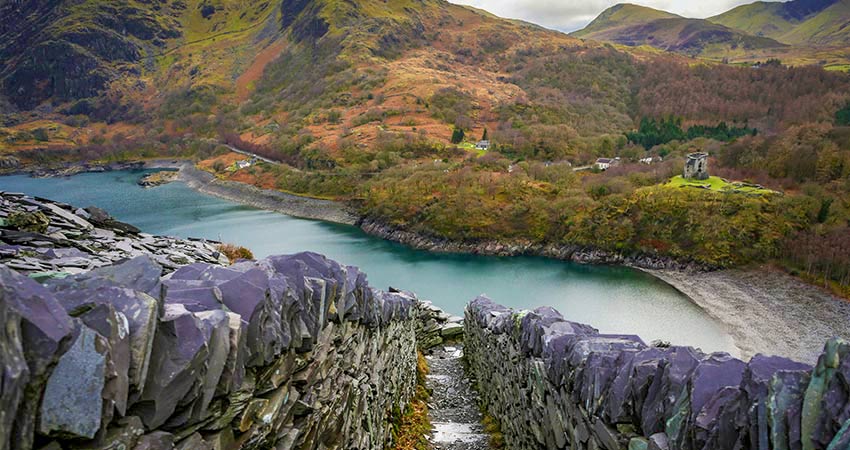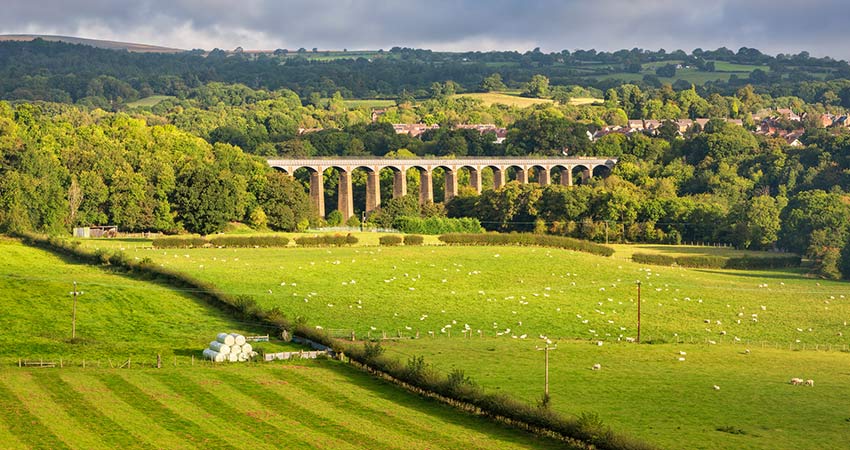Wales is small but it is mighty! History and landscape intersect here, and there are four UNESCO sites. Each is a testament to the hardy Welsh people, with poetry and song in their souls. After crossing the southern border of England, you may choose to explore the Brecon Beacons, rising to greet you. The nearby lofty peaks of Snowdonia are mythic. Rambling through the countryside and villages, you’ll come to feel that no country on earth as quite as many castles as Wales, and the cheeses and craft breweries cannot be beat.
Here are the UNESCO World Heritage Sites in Wales, each one a treasure.
The Slate Landscape of Northwest Wales
Go to Northwest Wales, around the county of Gwynedd, and you’ll come upon six sites that were part of the 19th century slate industry. This includes abandoned mining villages, old railway lines, a few grand manor houses that belonged to wealthy quarry owners, and the historic quarries. Their story is cut into the shelves of Snowdonia’s mountains.
When you visit, go to the National Slate Museum. Victorian workshops sprawl beneath the shadow of Dinorwig Quarry. You’ll hear the story of how the slate industry impacted Wales and its people; daily life was hard, and work was unrelenting. There are also demonstrations of the crafts and myriad of ways people held their families together.
When you finish up there, take a breather and explore Snowdonia. Consider hiking a trail or boarding the 200-year-old Ffestiniog Railway. If you’re into thrills, see the Penrhyn Slate Quarry on Velocity2 at Zip World Penrhyn Quarry, one of the fastest zip lines in the world. Down the coast is Talyllyn Railway, steaming from the ocean to the Abergynolwyn.
Castles and Town Walls of King Edward I
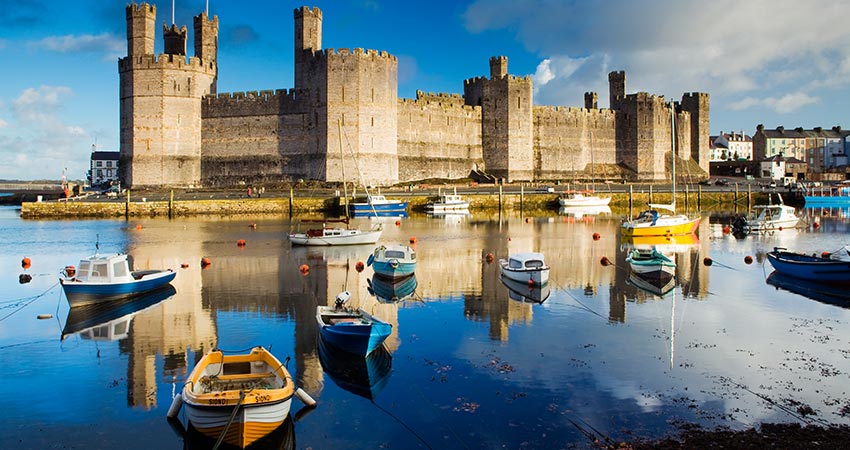
Edward I, known as Longshanks or The Hammer of Scotland, invaded Wales over a lengthy period of time. The four castles he built are the best-preserved examples of military architecture in the United Kingdom. Conwy Castle in the county of Conwy, Harlech Castle and Caernarfon Castle in Gwynedd, and Beaumaris Castle on the island of Anglesey are all reminders of England’s power in the 13th century. The fearless Welsh people resisted, time and again.
The towns of Conwy and Caernarfon are also part of the UNESCO designation. Conwy is situated on the Conwy River and is one of the finest preserved medieval fortresses in Europe. Visit Conwy Castle and explore the haunting nooks and crannies. The town walls, at 4,300 feet long and 21 feet tall, were built at the same time as the castle, between 1283 and 1287. These walls are in splendid shape and are a prime medieval site.
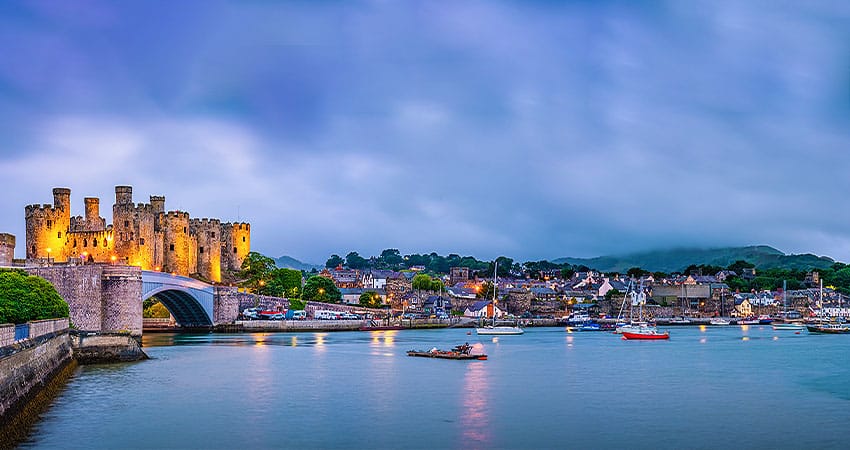
Caernarfon, twenty miles north of Conwy, may be the most imposing of Longshanks’ buildings. Climb the steep stairs to Eagle Tower, with its three turrets, and you’ve come to the place where Edward II, the first Prince of Wales, was born. Each town near the castles are lovely. The Plas Mawr townhouse, Conwy, is thought to be one of Britain’s best surviving Elizabethan townhouses. The Segontium Roman Fort, just east of Caernarfon’s center, was built in 77 AD and held 1,000 soldiers. Go to the shambles of Beaumaris for beautiful beaches, forests, and the town with the longest name in Wales—take a selfie!
Pontcysyllte Aqueduct and Canal
Cross the stream in the sky… UNESCO describes this World Heritage Site as ‘a masterpiece of creative genius’. There are nineteen symmetrical metal arches and a lockless design, meaning it has the same water level throughout. The Llangollen Canal, at 11 miles long and 126 feet above the River Dee, is an exceptional example of engineering and includes embankments, tunnels, viaducts, and aqueducts along with thirty-one other listed structures, called An Ancient Monument of National Importance.
You can boat this highest navigable aqueduct in the UK yourself or hire a boatman. You might also get on a horse and carriage and ride along the shore, bicycle the length, or walk it. Nearby are two important castles: Chirk and Llangollen. Chirk was built in 1295 by Edward I to subdue the last princes of Wales. It was in turn owned by a grocer, sugar trader, and a privateer. With over seven hundred years of history, it’s the last castle of this period that people still live in, and you’re invited to visit.
The interior is as lavish as you would expect of a fine castle, with remarkable paintings, tapestries, servants’ hall, and a chapel music room. The manicured gardens cover 5.5 acres and are home to herbaceous borders, roses, rock gardens, and a pleasure ground. The entire grounds cover 480 acres of parklands, complete with grazing sheep and cattle. Llangollen’s Castell Dinas Bran is quite different and just as fascinating. It’s a hilltop fortress that is built over a haunting Iron Age fort.
Blaenavon Industrial Landscape
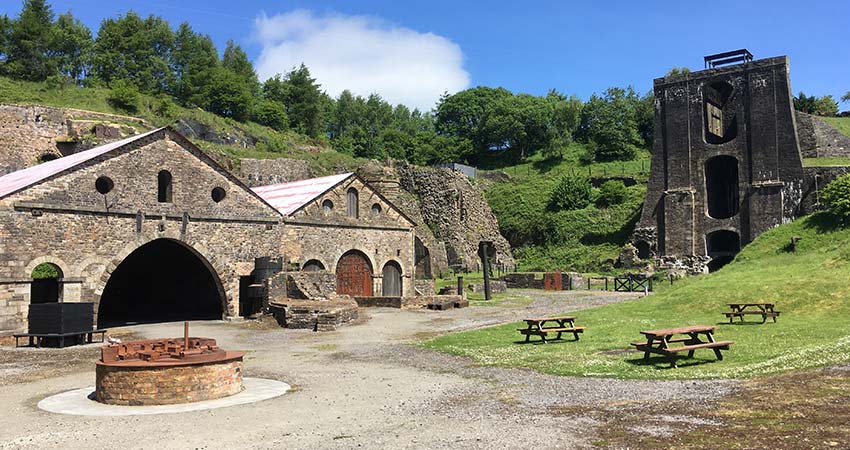
The British Industrial Revolution changed South Wales. The preserved buildings and industrial machinery in the old mining town of Blaenavon exemplifies this period of Welsh history. The town’s Old Iron Works has giant stone structures, part of the iron-making process, as well as blast furnaces, and the old water balance tower. The tower, a new innovation, moved wagons filled with coal between tracks, using water-filled weights.
If you’d like, you can go underground for an authentic look at the way miners worked until 1980 at the Big Pit National Coal Museum. Head three hundred feet below ground, and a miner gives you a tour while telling you his own experiences. Nearby, the valleys of South Wales are dotted with small communities tucked into lush hillsides. The town of Brynmawr has The Market Hall, the oldest movie theater in Wales, and a must for film buffs. Explore Raglan Castle, 20 minutes away, to see one of the last true castles built in Wales.
Over two million Americans have Welsh ancestry. You may travel to Wales to discover your roots, or you may simply want a United Kingdom experience that’s a bit off the beaten path. Wales is perfect for those who want breathtaking scenery, unusual historic sites, and welcoming people.
If you’re planning travel to England, let your Destination Expert know that you’d like to dive into Wales. It’s a trip into the awesome and inspiring.


